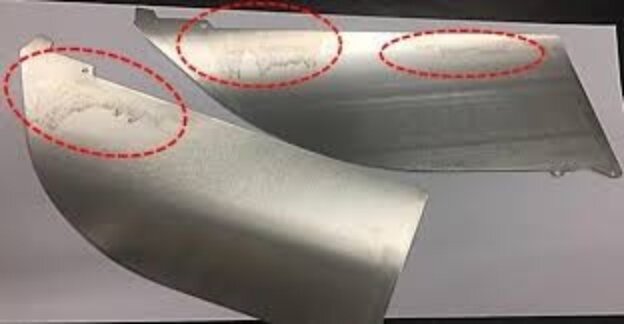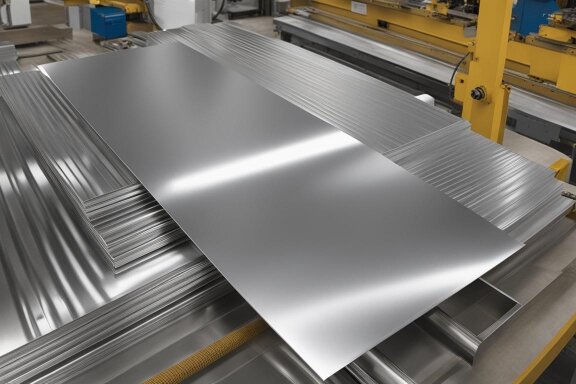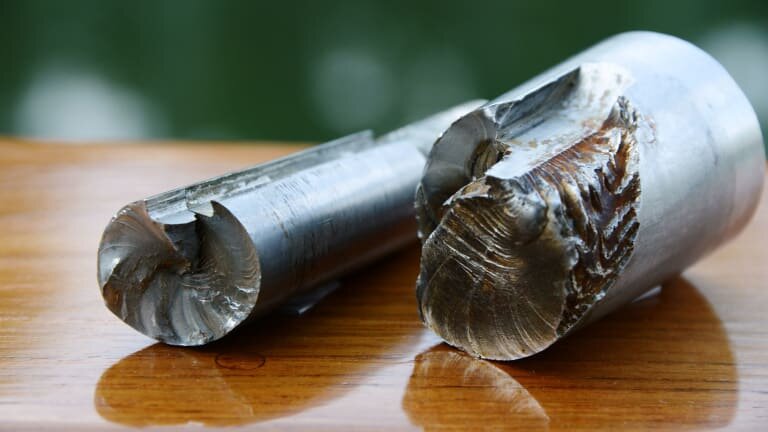Our success is dependent on the tools and techniques that we use. We’re always exploring and optimizing. Regarding sheet-metal fabrication, one method always stands out: TIG welding. What is TIG weld, and why is it so important in our field?
TIG (Tungsten Inert gas) welding is a process where an arc of electricity forms between the non-consumable tungsten electrode and the metal to be welded. In this process, an inert gas (typically argon) protects the weld from contaminants. This ensures a clean, precise weld.
As a client concerned about precision and quality, you want to learn more about this fascinating procedure. And I am thrilled to share this fascinating process!
We are unveiling TIG Welding: The Basics.
I often discuss the processes and techniques that ensure product quality. TIG welding is one of these essential techniques. I am excited to share some basic knowledge about TIG welding, a vital process in sheet metal fabrication.
Definition for TIG Welding
TIG stands for Tungsten Inert Gas welding. It’s a process of welding that uses non-consumable electrodes to create a weld. What does this mean to us, particularly in sheet metal fabrications?
Imagine a clean, precise, electric solid arc between a tungsten rod and the metal you want to join. Inert gas is the shielding gas used to protect the weld area from airborne contaminants. This shield will ensure that the weld produced is solid and free from imperfections that could compromise its strength and appearance.
TIG Welding Principle
TIG welding creates an arc. It does this by placing the tungsten electrode between the workpiece and the electrode. The heat generated by the turn melts the base metal. The welder can add filler metal as the molten pools form to help join pieces together.
The welder can control the process to a fantastic degree. You can adjust the arc’s intensity. This ensures the metal melts without warping or burning through. This level of control becomes even more critical when dealing with thin metals and complex designs.
Using an inert gas shield ensures that the pool of molten metal remains uncontaminated. Gases in the atmosphere, such as oxygen or nitrogen, can negatively affect a weld’s quality by making it porous or brittle. TIG welding produces strong, durable, and clean welds by preventing these contaminants from entering the weld.
TIG Welding vs. Other Welding Methods
I want to discuss how TIG welding compares with other welding methods and why it is often our preferred method.
TIG vs. MIG Welding: Key Differences
Metal Inert Gas Welding (MIG), known as “hot glue gun,” is a relatively easy-to-use method. This is how MIG welding compares to TIG:
- Type of Electrode: TIG uses a non-consumable metal electrode. In contrast, MIG uses a continuously fed wire as the electrode.
- Shielding Gas: Both methods use inert gas to protect the weld. MIG, however, often uses a CO2 mixture in the shielding gases, particularly when welding steel.
- Skill Level: TIG requires more excellent talent and skill. Beginners usually start with MIG because it is more straightforward.
- Applications: TIG excels when precision and aesthetics are essential, as with thin materials or cosmetic welding. MIG is faster and is better for thicker or longer materials, where appearance is not the main priority.
Stick Welding: A Comparison of TIG and Stick Welding Stick Welding: Comparison
Stick welding is an ancient and robust method. This is how it compares to TIG:
- Electrode and Filler: Stick welding uses a consumable, flux-coated electrode. The flux shields the weld pool as the electrode melts. On the other hand, TIG uses a non-consumable electrolyte and separate filler materials, giving more control.
- Environment: Stick welding suits outdoor environments where the wind can disperse gas. TIG is best used in controlled environments, requiring a constant gas shield.
- Material and Thickness: Stick welding is versatile and works best with thicker materials. It is also less sensitive to contamination. TIG is also versatile but shines with thinner materials and alloys.
- Finish and Cleanliness: Stick welding is often messy and results in much spatter. You must remove the slag after welding. TIG produces a slag-free cleaner weld, reducing the cleanup required after welding.
TIG Welding Benefits
Each welding method has strengths. However, TIG welding is a popular choice in Shengen because of its distinct advantages:
- Precision & Control: You can instantly adjust the heat input. This allows for the precise execution of intricate and delicate tasks.
- Welds that are Clean: The welds have no spatter and slag. They’re ideal for visible parts or premium projects.
- Versatility: TIG is adaptable and capable of welding metals of different alloys.
- Quality: TIG welding is a durable and robust method of joining metals.
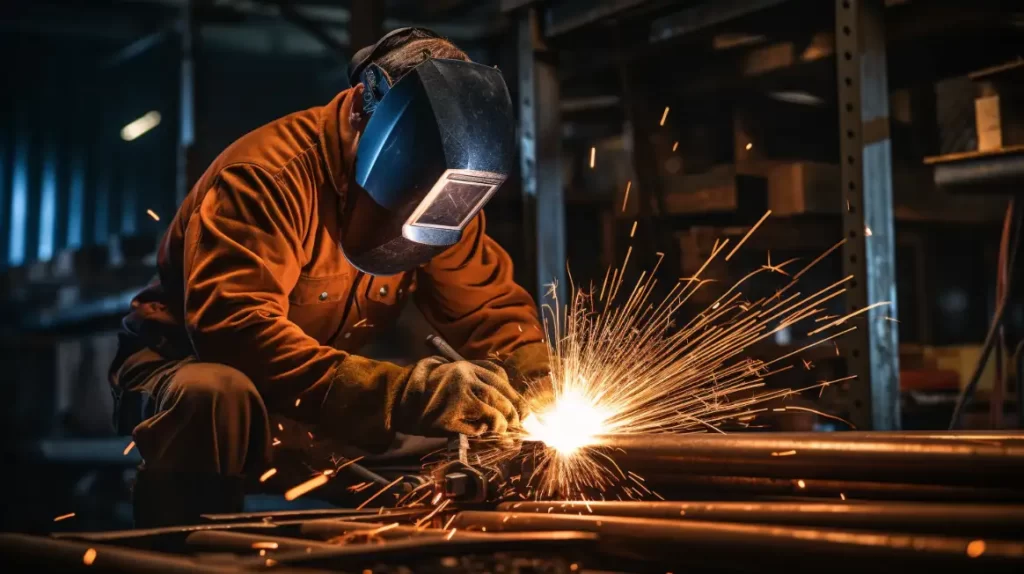
The Core Components for a TIG Setup
TIG welding is an art, but its foundation is firmly rooted in technology. We’ll take a look at the components that comprise a TIG setup. These are the unsung heroes who make our products so perfect.
TIG Torch Parts
The TIG torch acts as the TIG welder’s instrument. It delivers shielding gas and directs current to the welding area. It is made up of the following main components:
- Tungsten Electrode: This is the heart of the torch. It channels the current to create an arc. It is non-combustible and does not melt during welding.
- Collet and Collet Body: These parts secure the tungsten electrode in place. The collet helps direct the flow of shielding gas.
- Ceramic Nozzle: This surrounds and concentrates the shielding gas on the weld, protecting it from atmospheric contamination.
- Torch body: The torch body is often water- or air-cooled and contains channels that dissipate the heat. This ensures the torch stays at a safe operating temperature.
Power Supply Essentials
In TIG welding, the power supply is crucial. The power supply provides a controlled, stable current for the welding process. Here’s what’s essential:
- AC/DC Capability: While DC is the most common current for most metals, AC is necessary for welding aluminum, which forms an oxide film. AC breaks down the oxide layer to allow for welding.
- Amperage range: Different materials or thicknesses require different amperages. A versatile power supply offers a wide range and is suitable for many tasks.
- Hand or Foot Control: This allows you to control the heat input on the fly and, therefore, the welding process.
Shielding gases and their roles
The shielding gas is used in TIG welding to protect the weld pool against atmospheric contaminants such as oxygen and nitrogen. The most commonly used gases include:
- Argon: It is ideal for TIG welding, providing a stable arc.
- Helium: Often added to increase the heat input. It’s beneficial for thicker material or when a greater penetration is needed.
- Argon and Helium Mix: This mix welds metals such as aluminum.
Electrodes in Their Varieties
The electrode you choose can affect the quality and stability of your weld. The primary material is tungsten, but its alloys and additives may vary.
- Tungsten Pure (Green): It is mainly used with AC to weld aluminum.
- 2 % Thoriated (Red): Known for its durability and constant arc, this is suitable for DC welding.
- Created (Grey), 2%: This power supply is versatile. You can use it for both AC and DC.
- 1,5% Lanthanated Gold: You can use this universal electrode with both AC and DC settings.
How to Tig Weld: Step-by-Step
Understanding the TIG welding process is essential to appreciate its artistry fully. We’ve already discussed the advantages and components of TIG. We’ll look at the TIG process step by step to see how it transforms raw material into intricately crafted parts.
How to Prepare Metal Surfaces
Preparation is essential before you even think about starting an arc. Welding on uneven or contaminated surfaces can reduce the weld’s quality.
- Cleaning: Surfaces are cleaned with a wire brush to remove contaminants like rust, paint, or oil. The cleaner the metal is, the better it will weld.
- Fit-up: Fit-up is the process that ensures the metal pieces are firmly seated. A tight fit-up will provide a high-quality and consistent weld.
Set up the Equipment
You must prepare the equipment for the task.
- TIG Torch: The tungsten electrode to use is selected based on the thickness and material of the metal. The electrode is then attached to the torch.
- Power Supply: On the machine, you can set the desired amperage. Keep in mind that thicker materials require more amperage.
- Shielding Gas: The regulator controls the gas flow rate. Typically, a 10-20 cubic feet per hour (CFH) rate may vary depending on the task or conditions.
Starting the Arc
Here is where the magic starts and a molten pool will form.
- Torch Positioning: By holding the torch at a 15-degree angle, you can achieve optimal gas coverage and arc control.
- Striking an Arc: You can start the arc by scratching (physically scratching) the electrode on the metal or using high-frequency (starting the bend with no contact with the metal).
Filler material: What is its role?
Although TIG welding is possible without filler, many welds need additional material to increase strength and volume.
- Selecting the Filler: You choose the filler rod based on the metal you’re welding.
- Add the Filler Rod: Hold the filler rod away from the torch as you introduce it to the molten metal pool. The welder dips and re-dips the rod into the pool to ensure a uniform bead.
Cleaning and Finalizing the Weld
After laying the bead, the final touches affect the weld’s appearance and quality.
- Terminating an Arc: By reducing the amperage with a foot pedal or using the machine settings, you can gently taper off the arc, resulting in a neat weld termination.
- Cleaning after TIG Welding: Although TIG welding creates clean welds (known as post-weld coloration), there may still be some oxidation. Depending on your material and desired finish, you can clean this with a wire brush, polishing pad, or chemical cleaners.
Safety measures in TIG welding
TIG welding is a process that comes with risks, just like any other industrial process. We can minimize these risks with the proper precautions, protecting our team and quality products. We will now examine the safety measures that are the foundation of our TIG operations.
Personal Protective Equipment (PPE) is an essential part of personal safety.
The right personal protective equipment is the first defense against potential welding hazards.
- Helmets for welding: These helmets have an auto-darkening lens that protects the eyes from UV and IR rays emitted by the welding process. These helmets also protect the face from spatter and sparks.
- Protective Clothing: Flame-resistant Clothing, usually made from leather or unique fabrics, protects against burning. To prevent UV exposure, high collars and long shirts are essential.
- Gloves:These gloves are designed for welding and protect from heat, electric shock, and sparks.
- Protection Shoes: Safety footwear is essential in industrial environments. It protects workers from falling objects, hot materials, and sharp objects.
Ensuring Proper Ventilation
Gases and fumes can be harmful during the welding process. Good ventilation is crucial to maintain breathable and safe air.
- Exhaust Local Ventilation: These systems sit near the welding area and efficiently remove fumes, gases, and other contaminants.
- Ventilation: Regularly refreshing workshop air helps disperse residual pollutants that may escape local exhaust systems.
- Respirators: In situations where ventilation may not be adequate, wearing a respirator provides additional protection from inhaling harmful substances.
Electrical Safety Measures
Since TIG welding is a process that involves electricity, it is essential to take precautions against any electrical hazards.
- Grounding: Ensure the welding machine is properly grounded to prevent electric shocks or short circuits.
- Inspection: Checking equipment regularly for wear and tear or damage will ensure they are safe to use. Cables, in particular, should be free of cracks and breaks.
- Dry Work Environment:Electric shocks are more likely to occur when welding in damp conditions. As always, ensure that the workspace is dry.
Storing and Handling Gases Responsibly
Since TIG welding utilizes shielding gas, storing and handling the gas is essential.
- Cylinder storage: Store gas tanks upright, in a dry, cool place away from sunlight and any other heat source.
- Cylinders Secure: Use chains or stands to secure cylinders so they don’t fall or get knocked.
- Gas regulators:These devices regulate the gas flow between the cylinder and the torch. Please make sure they are in good condition and that there are no leaks.
- Avoid Mixing Gases: Check the label of each gas before connecting it. If you accidentally use the wrong gas, it can lead to poor-quality welds or even dangerous reactions.
Tips and Tricks for Perfecting the Art
We’ve learned much over the years and are eager to share our knowledge. These tips and tricks will make your journey easier and produce better results, whether you are a welder with years of experience or just starting.
How to Weld Cleanly and Strongly
It is more than just aesthetics. A beautiful weld represents strength, precision, and skill. Welds that are strong and clean can be achieved by following these steps:
- Surface Preparation:As we have already stressed, a clean surface must be the first step. Remove all rust, contaminants, and oil. Clean surfaces ensure optimal conductivity and fusion.
- Pulse Welding: Modern TIG machines have a pulse setting. This can reduce the heat input, minimize warping, and produce cleaner welds on thin materials.
- Torch Angle: By holding the torch at a right angle, the electrode will not touch the molten water while providing proper gas shielding.
Avoiding Common Pitfalls
Even experienced welders face challenges. Avoid common pitfalls by following these tips:
- Tungsten contamination:The tungsten electrode can be contaminated if it touches a molten pool or a filler material. If this happens, stop and re-grind the tungsten electrode to a point.
- Porosity: Porosity is a problem if your weld appears to have tiny bubbles or holes. Contaminated materials or poor gas shielding can cause problems. Make sure the gas flow and materials are clean.
- Wandering Arc: A stable arc will ensure consistent welding. Your torch might wobble if the tungsten isn’t properly ground or the arc length is too long. Adjust your setup as needed.
How to Maximize the Lifespan and Performance of Equipment
The quality and productivity of our work are directly affected by the longevity of our equipment. How do we make sure our equipment lasts a long time?
- Maintenance: Regular maintenance is essential to prevent unexpected breakdowns.
- Proper Storage:Store equipment in a clean, dry place when not in use. Gas cylinders designed to protect against fire should be stored upright and securely chained.
- Care of Electrodes: With the correct amperage and a clean point, you can extend the life of tungsten electrodes.
Aluminum TIG Welding: Navigating Its Unique Challenges
Many industries use aluminum, from consumer electronics to aerospace. It’s lightweight, strong, and corrosion-resistant. Over the years, we’ve developed a science and an art to TIG weld aluminum. Let’s explore the nuances of TIG aluminum welding.
Unique Properties of Aluminum
Understanding aluminum’s properties before diving into welding is essential:
- Oxide Layer: Aluminum forms a thin oxide layer that protects it. This layer is excellent at preventing corrosion but has a melting temperature of three times that of aluminum. It is, therefore, essential to break through this layer for welding to be practical.
- Thermal Conductivity: Aluminum is a good conductor of heat, and its high thermal conductivity allows it to dissipate heat quickly. This property can benefit many applications but requires higher amperage during welding.
- Hardness: Aluminum’s flexibility can be a problem when welding fragile aluminum.
Preparing for TIG Welding Aluminum
- Cleaning the Material: Cleaning the Material is essential due to the high melting point of the oxide layer. Scrub the surface using a stainless-steel brush that is only for aluminum. This breaks down the oxide and improves fusion.
- The Right Electrode: Although pure tungsten has been used traditionally for aluminum TIG welds, today, most welders prefer electrodes that are lanthanated. They maintain a more pointed shape for longer, have better arc stability, and use less amperage.
- Aluminum requires AC (Alternating current) mode:While you can weld steel with direct current, you must use alternating current for aluminum. AC breaks through the oxide, which allows for better weld penetration.
Tips and Techniques for Weld Aluminum With Tig
- Welding Pulse: The pulse feature of modern TIG machines helps control heat input and reduce distortion. It also improves overall weld quality on aluminum.
- Torch Angle: For aluminum, it’s recommended to use a push technique, angling the torch 10-15 degrees from vertical. This angle provides better visibility and gas shielding.
- Filler Material: A suitable filler is crucial. The most common choices are 4043 and 5356, with the former having a better flow and the latter offering superior strength.
- Foot Pedal:Aluminum heats up quickly, so the welder may need to adjust amps on the fly. A foot pedal allows for real-time control and ensures consistent welds.
Challenges & Solutions
- Porosity: Aluminum can develop porosity due to moisture, contaminants, or oil. Clean the material thoroughly, and make sure your shielding gas has dried.
- Cracking: The material might crack after welding because it cools rapidly. To prevent this, use a suitable filler material and design joints properly.
- Burn-through:With thin aluminum, you risk burning right through it. To prevent issues, use pulse welding, choose a larger electrode, and monitor the amperage.
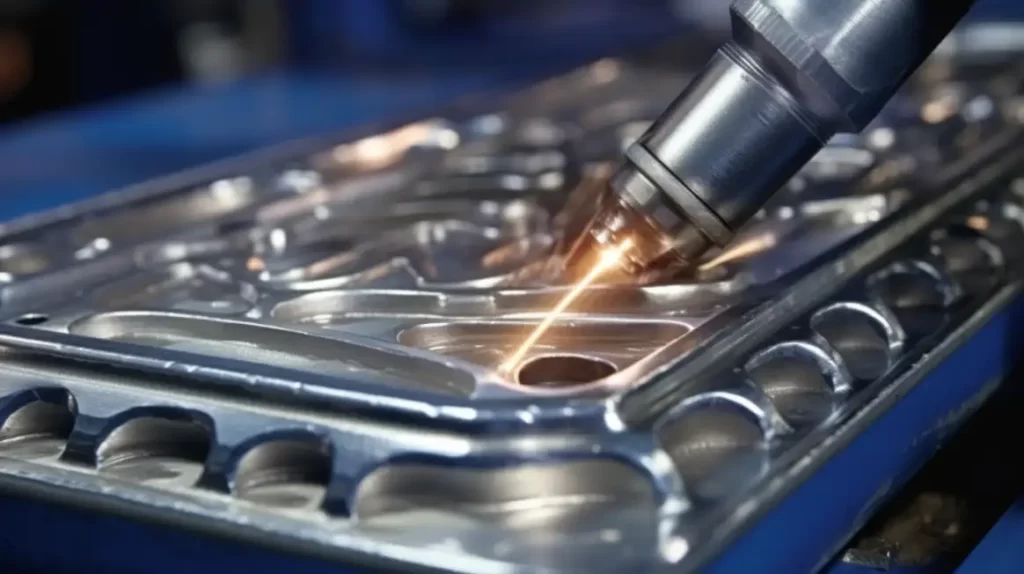
Stainless Steel TIG Welding: Combining Strength and Elegance
Stainless steel has a broad range of uses. From architectural marvels to complex machinery parts, it’s renowned for its strength, corrosion resistance, and lustrous surface. But TIG welding stainless steel has its challenges and rewards. We will explore the subtleties of TIG stainless steel welding.
The Distinctive Nature of Stainless Steel
Understanding stainless steel’s basic properties is essential for successful welding.
- Chromium Content: The corrosion resistance of stainless is due to its high chromium content. When exposed to oxygen, chromium forms an oxide layer that shields the material beneath.
- Heat Sensitivity:This type of stainless steel is more temperature-sensitive than regular. If mishandled, it could discolor or affect its anti-corrosion features.
- Low Thermal Conductivity:Unlike aluminum and other metals, stainless steel does not quickly dissipate heat. Because of this, handle stainless steel with care. Excessive heat can lead to warping or deformation.
Setting the groundwork for Stainless Steel Welding
- Surface preparation:A perfect surface is essential. Use a stainless steel brush to remove contaminants like oils or oxides.
- Electrode Choice: Choose a tungsten electrode that is thoriated or lanthanated for stainless steel. They provide a steady arc and a sharp tip, which ensures clean welds.
- Direct Current (DC), with Electrode Negative (DCEN): Using direct current with electrodes set to negative polarity for stainless steel welding. This setup concentrates heat onto the electrode and allows for deeper penetration.
Mastering The Craft: Techniques And Tips
- Pulse Welding: Modern TIG machines with pulse settings are advantageous. The pulse welding process controls heat input and minimizes distortion. It also offers a finer control of the weld pool.
- Torch Maneuvering:It’s recommended to give a slight push. Hold the torch at a 10-15 degree angle towards the weld direction. This will ensure better heat control and shielding gas coverage.
- Filler material:Fillers such as 308L or 316L can be used depending on the grade of stainless steel. The material properties and the desired result will determine the choice.
- Gas Selection: Pure argon, as a shielding gas, is the most common choice for stainless steel TIG welding. It produces a clean and stable arc.
Challenges – Overcoming them
- Heat tint:The heat generated during welding can cause discoloration. Use adequate shielding gases and gas lenses to improve coverage.
- Warping:Due to its low thermal conductivity, stainless steel can warp if exposed to excessive heat over a long period. You can reduce issues by using pulse or tack welding regularly.
- Sensitization: Excessive heating can cause carbide to precipitate at grain boundaries. This makes the material more susceptible to corrosion. You can prevent this phenomenon by choosing low-carbon stainless steel or stabilized varieties.
Environmental Concerns: How Green is TIG Welding?
Given the increasing emphasis on sustainable practices, it is essential to answer a fundamental question: how green is TIG? Let’s explore the environmental impacts of this popular welding technique.
Environmental Impact of TIG Welding
To assess the sustainability and environmental impact of TIG welding, we need to understand its different aspects:
- Electricity Consumption:As with other welding techniques, TIG welding is energy-intensive. Electricity consumption affects not only operational costs but also greenhouse gas emissions.
- Shielding gases:TIG welding uses inert gasses like argon or helium to protect the welding zone against contaminants. These gases are non-toxic, non-combustible, and do not pose any environmental hazards. However, the extraction and transport of these gases can cause serious problems. Helium is also a limited resource.
- Consumables & Waste:Tungsten electrodes, filler material, and other consumables can create waste if not adequately managed. The production and disposal of these products can impact the environment.
Greener TIG welding practice
TIG welding is environmentally harmful, but there are ways to mitigate this impact:
- Energy Efficiency: Modern, energy-efficient TIG welding machines can reduce power consumption by a significant amount. Routine maintenance will ensure that the machines run optimally and minimize energy waste.
- Recycling Tungsten Electrodes: Recycling programs are a great way to recover and reuse tungsten electrodes. This reduces the need for new extraction and refinement.
- Responsible Gas Management:By minimizing gas waste by using flowmeters and ensuring no leaks within the system, you can reduce the need for shielding gas. It is also more environmentally friendly to use argon instead of helium because it is abundant.
- Recycling and Waste Reduction: By taking a proactive approach to waste management – from collecting metal scraps and filings to recycling consumables – you can reduce the environmental impact of TIG welding.
- Sources of Renewable Energy: Using renewable energy sources like solar or wind to power welding operations can reduce greenhouse gasses associated with this process.
Adopting a Holistic Environment Perspective
Beyond these direct measures, cultivating an environmentally conscious organizational culture is paramount:
- Employee Training:When our staff and welders know sustainable practices, we can enhance our green efforts. This includes efficient machine use, proper waste disposal, and understanding the broader environmental implications of their job.
- Continuous research and adaptation:The world is constantly changing. We can continually refine our processes by staying up-to-date with the latest sustainable technology and methodologies.
- Engagement of Stakeholders: Working with customers, suppliers, and other stakeholders to promote sustainability is a collaborative and effective way to approach environmental responsibility.

Repair & Maintenance: How often does TIG welding equipment need servicing?
The efficiency and longevity of our TIG setups depend on timely repairs and maintenance, just like any other machinery. We’ll look at the maintenance routine for TIG welding machines to ensure optimal performance and durability.
Understanding Wear and Tear of TIG Welding equipment
TIG welding requires high standards of precision from the equipment. Wear and tear is affected by several factors:
- Intensity: Equipment used continuously in heavy production environments will require more frequent maintenance than equipment in light-duty applications.
- Conditions of Operation:Work environments laden with contaminants, dust, or moisture can expedite wear on the welding equipment.
- Consumables Quality: The quality and quantity of consumables can affect equipment health.
The Servicing Timeline: a Guided Approach
- Daily Inspections:
- Before starting any welding, it is essential to perform a quick inspection.
- Make sure cables are not frayed and intact.
- Verify that the gas flow rate is correct and there are no leaks.
- Weekly or bi-weekly maintenance:
- Clean the exterior of the welding torch and inspect its interior to check for blockages.
- Check the ground clamp to ensure it is securely connected and that there are no signs of wear.
- Check all hoses, fittings, and hose ends for signs of wear.
- Monthly assessments:
- Ensure that the power source is working correctly. Monitor for stable performance and consistent arc start.
- Check for leaks and flow rates in the cooling system if you have a water-cooled TIG welder.
- Check the condition of your tungsten electrode. Replace it if needed.
- Annual Servicing:
- A thorough professional inspection is recommended annually of the TIG setup. It is essential to check the condition of internal components, electrical connectors, and other integral pieces.
- By cleaning or replacing filters and ensuring optimal airflow, you can avoid overheating the machine and extend its life.
- Calibration tests ensure equipment operates within the specified parameters, providing the welds’ quality.
Signs that Immediate Service is Needed
The above timeline is a guideline only. Be alert to signs that your equipment might need immediate attention.
- Need for more welding performance or consistent arc start.
- The machine or torch has overheated.
- Unusual sounds or vibrations during operation.
Shengen Philosophy: Reactive repair over proactive care
We at Shengen believe that prevention is better than cure. Regular proactive maintenance reduces unplanned downtimes and costly repairs. It also ensures that our products are of consistent quality. As we delicately create intricate components, our equipment should be handled carefully.
What is the Future of TIG Welding?
The industry is constantly evolving, driven by changes in technology and demand. TIG welding, a cornerstone of our business, is no exception. Let’s look into the crystal ball of the future and explore the trends and transformations that will redefine TIG welding.
Technological Advancements at the Horizon
- Intelligent Welding Machines: Integrating Artificial Intelligence and the Internet of Things into TIG machines is rapidly becoming a reality. These “smart” machines will provide real-time feedback and automated parameter adjustments. They may even send out predictive maintenance alerts. It not only increases precision but also reduces the need for manual oversight.
- Augmented Reality for Training:The future generation of welders may just put on their AR goggles and learn the finer points of TIG welding. AR overlays virtual weld seams on accurate workpieces to guide the learner and ensure they master the correct technique.
- Remote Welding:Robotics and remote sensing let us control TIG welding from a distance. This technology could be invaluable in hazardous or challenging environments where human interaction is impossible.
- Advanced Power Source Technology: In the future, TIG welding power sources could be more energy efficient and capable of switching between power modes depending on the welding task. This would ensure optimal power usage.
- Green Welding Solutions: As the world moves towards sustainability, TIG welding innovations will focus on reducing their environmental footprint.
Shifts possible in industry demand
- Increase in Aerospace and Automobile Demand: As the aerospace and automotive industries move towards lighter and more durable materials, demand for TIG welding, known for its clean and robust welds, will soar.
- Customization over Mass Production: With industries increasingly valuing customization, TIG welding will be at the forefront of bespoke manufacturing.
- Sustainability Manufacturing: As enterprises become more environmentally aware, the demand for TIG weld solutions aligned with green manufacturing techniques will likely increase.
- Increased Emphasis on Quality Over Cost: There may be a greater emphasis on quality over cost. TIG welds are known for their high quality, which could increase demand for TIG-welded parts.
Conclusion
Shengen’s TIG welder is a valuable tool in the arsenal. It is time-consuming and requires skill, but the results are worth it in terms of precision. Our commitment to excellence and quality drives us to adopt and perfect these techniques. Serving clients worldwide, we ensure we use the best practices to bring your visions to life.
Do you need a reliable sheet metal parts manufacturer? Shengen is the place to go. We specialize in sheet metal laser cutting, bending, surface finish, and sheet metal welding. We place a high priority on establishing trust, maintaining standards of quality, providing competitive prices, and guaranteeing timely delivery. Reach out to Shengen Today and seek help from professionals!
More Resources:
AI-integrated TIG welding machines – Source: MDPI
Green Welding Solutions – Source: GlobalSpec
Common Metals You Can TIG Weld – Source: Wcwelding
Hey, I'm Kevin Lee

For the past 10 years, I’ve been immersed in various forms of sheet metal fabrication, sharing cool insights here from my experiences across diverse workshops.
Get in touch

Kevin Lee
I have over ten years of professional experience in sheet metal fabrication, specializing in laser cutting, bending, welding, and surface treatment techniques. As the Technical Director at Shengen, I am committed to solving complex manufacturing challenges and driving innovation and quality in each project.


